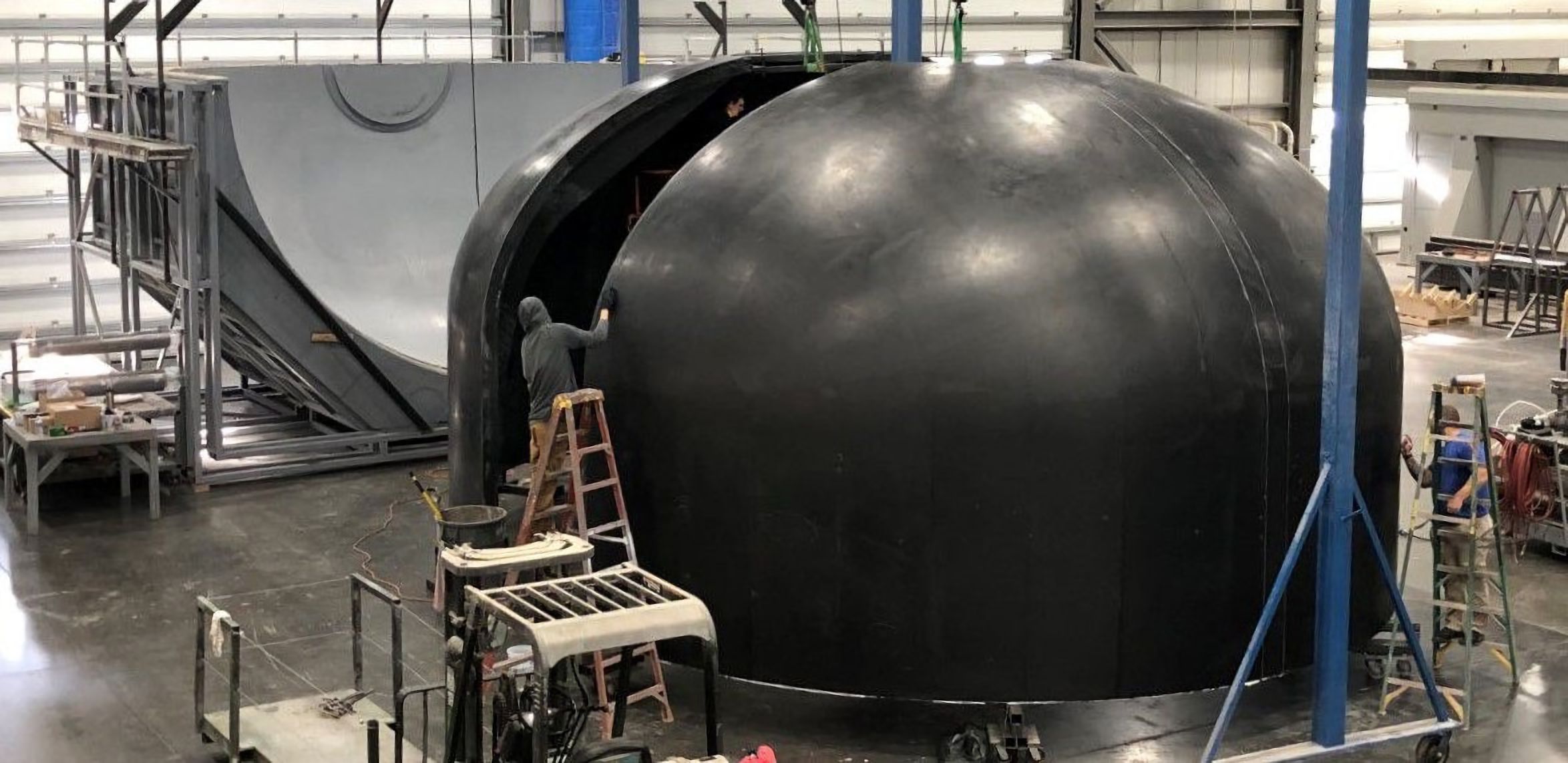
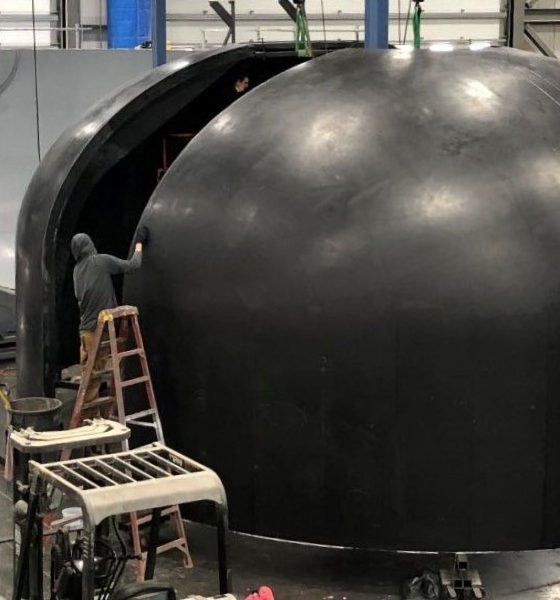
News
Rocket Lab assembling first reusable Neutron rocket hardware
Rocket Lab appears to have made significant progress since revealing the state of hardware development for its next-generation Neutron rocket in a September 2022 investor update.
At the time, the company shared photos of early work on prototypes of smaller Neutron structural elements, as well as progress building the giant molds that will be used to ‘lay up’ the rocket’s carbon fiber composite tanks and airframe. Rocket Lab also showed off acquisitions of some of the supersized manufacturing equipment that will be used to build the giant rocket, as well as the beginnings of a dedicated Neutron factory in Virginia.
Four months later, photos shared by CEO Peter Beck show that Rocket Lab has progressed to full-scale carbon fiber hardware manufacturing. In December 2022, Beck shared a photo of a full-size Neutron tank dome in the middle of production. A month later, Beck shared a photo of work on both halves of a Neutron booster tank dome. Measuring around seven meters (23 ft) wide, the latter component is already on track to become one of the largest carbon fiber structures ever prepared for a rocket once the halves are joined. And once two more halves are built and assembled, Rocket Lab could soon be ready to start testing full-scale Neutron tank hardware – a crucial milestone for any new rocket.
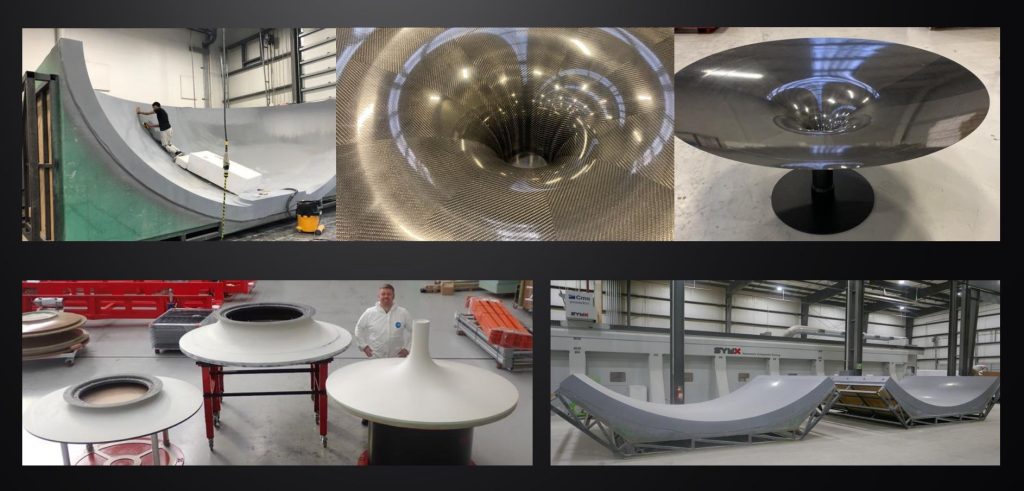
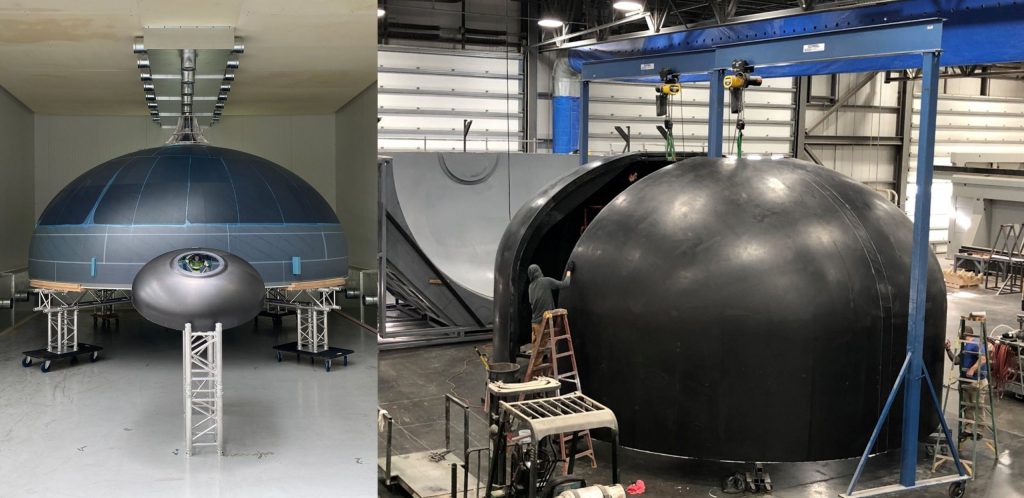
The update that's rolling out to the fleet makes full use of the front and rear steering travel to minimize turning circle. In this case a reduction of 1.6 feet just over the air— Wes (@wmorrill3) April 16, 2024
Announced in March 2021 and properly unveiled in December 2021, Neutron is a partially-reusable two-stage rocket designed to launch up to 15 tons to Low Earth Orbit (LEO) using liquid methane and oxygen propellant. Neutron measures 42.8 meters (140.4 ft) tall and up to seven meters (23 ft) wide. Its stout, ballistically-optimized design means that it’s simultaneously 40% shorter and up to 190% wider than SpaceX’s workhorse Falcon 9 rocket.
Design differences aside, Neutron is the first rocket that has been obviously designed as an answer to Falcon 9, which has become one of the most prolific, cost-effective, and routinely reusable rockets in the world over the last five or so years. Depending on how much Rocket Lab can sell Neutron for while still breaking even, Neutron has the potential to give Falcon 9 a serious run for its money – or at least force SpaceX to lower its prices. Like Falcon 9, Neutron will have a reusable booster, a reusable payload fairing, and an expendable upper stage. Its booster will also have nine (Archimedes) engines and the upper stage will be powered by one engine. At liftoff, Neutron will produce up to 674 tons (1.49M lbf) of thrust to Falcon 9’s 770 tons (1.7M lbf).
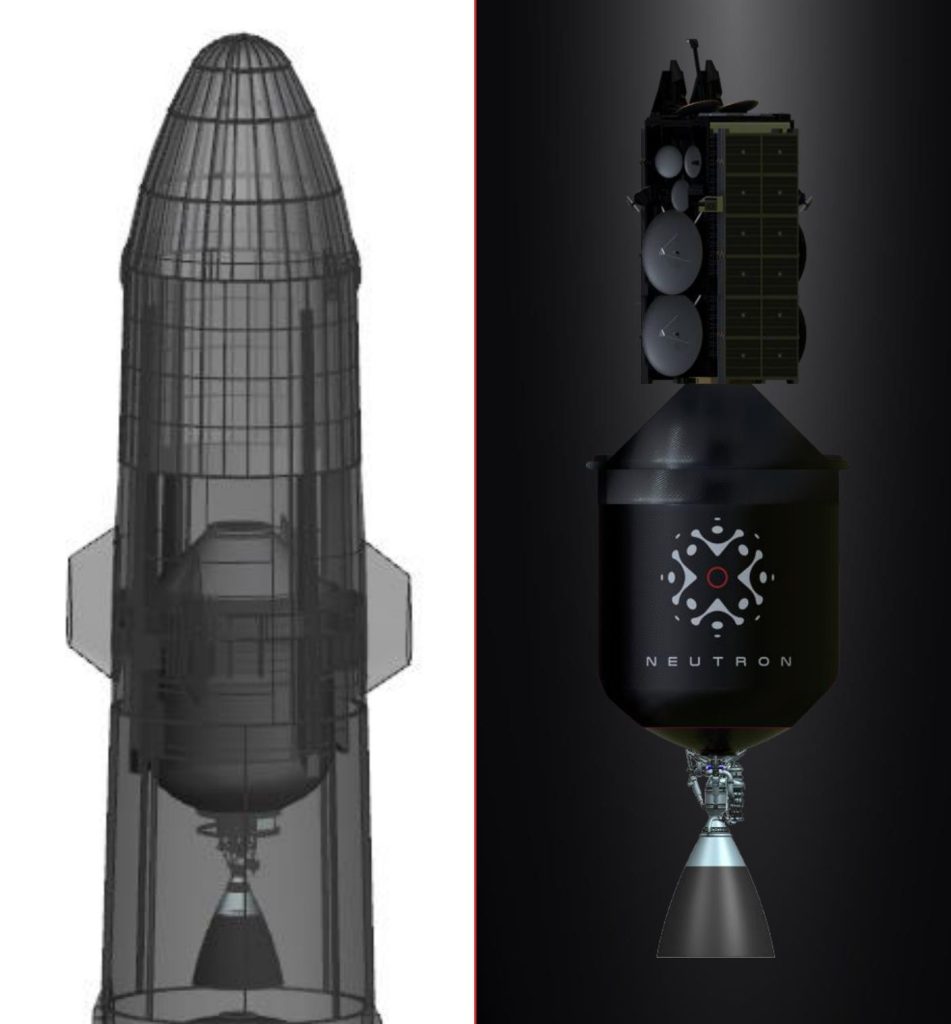
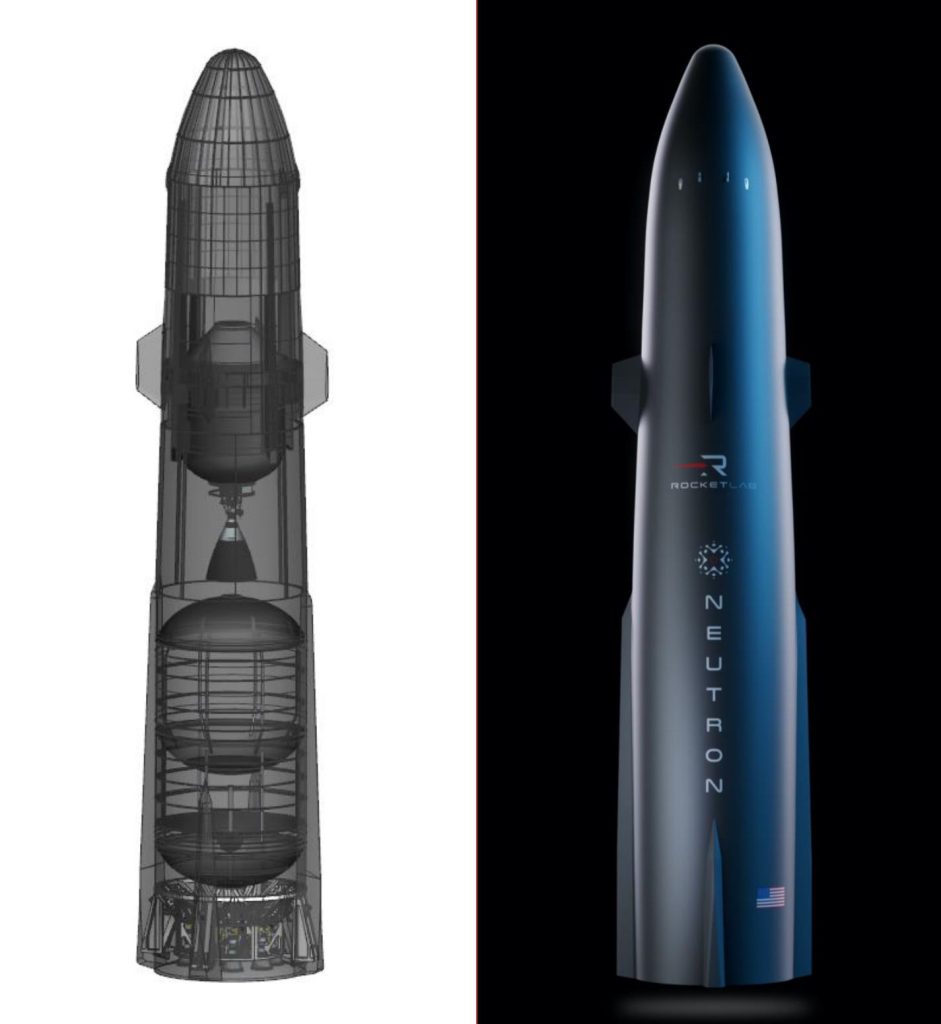
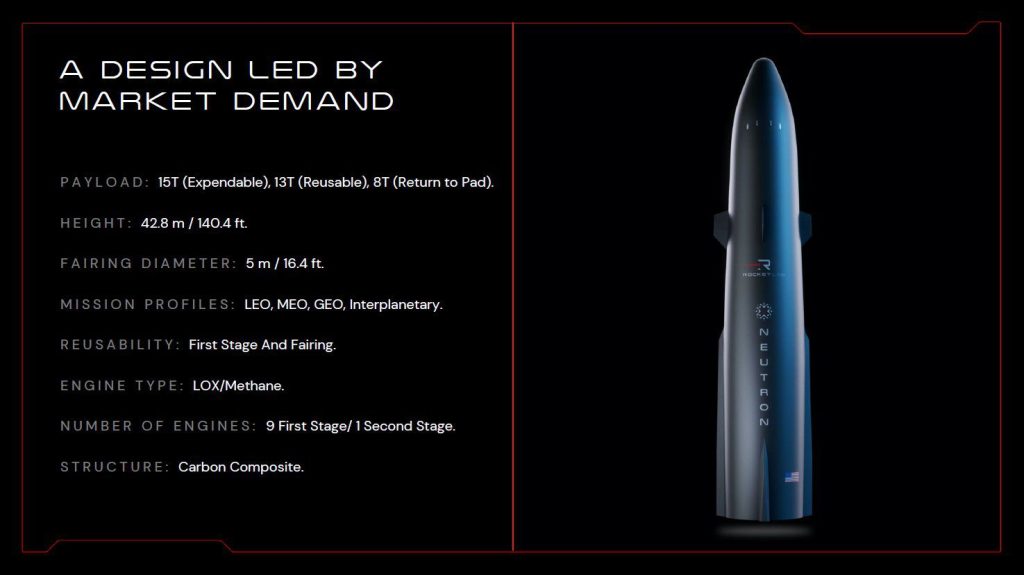
Unlike Falcon 9, Neutron’s similarly-sized reusable fairing is integral, meaning that it will stay permanently attached to the booster. But despite the added mass of the integral fairing and the rocket’s significantly shorter layout, Rocket Lab says that Neutron will be able to launch up to 13 tons (~28,700 lb) to LEO if the booster lands on a barge downrange. Using the same approach with a deployable fairing, Falcon 9 has launched up to 16.7 tons (~36,800 lb) to LEO. That 23% performance gap may seem significant, but the reality is that only SpaceX’s own Starlink and Dragon missions have ever needed Falcon 9 to launch more than 13 tons to orbit.
If Neutron can consistently launch ~25% less payload than Falcon 9 to all Earth and near-Earth orbits, virtually every commercial launch contract that’s currently a SpaceX shoo-in could be within reach of Rocket Lab within several years. The challenge, of course, is building Neutron and making sure the ambitious rocket and its clean-sheet Archimedes engine work as expected and can be reused as easily as Falcon 9.
The company is attempting to get there with its far smaller Electron vehicle, but Rocket Lab has never reused a rocket. And five and a half years after Electron’s debut, the company has never launched more than nine times in one year. SpaceX is about to reuse a Falcon booster for the 140th time and launched 61 times in 2022 – a lead that may prove almost impossible to close. There’s also the fact that the size gap between Rocket Lab’s rockets is so extreme that Neutron could likely launch a fully-fueled Electron into orbit.
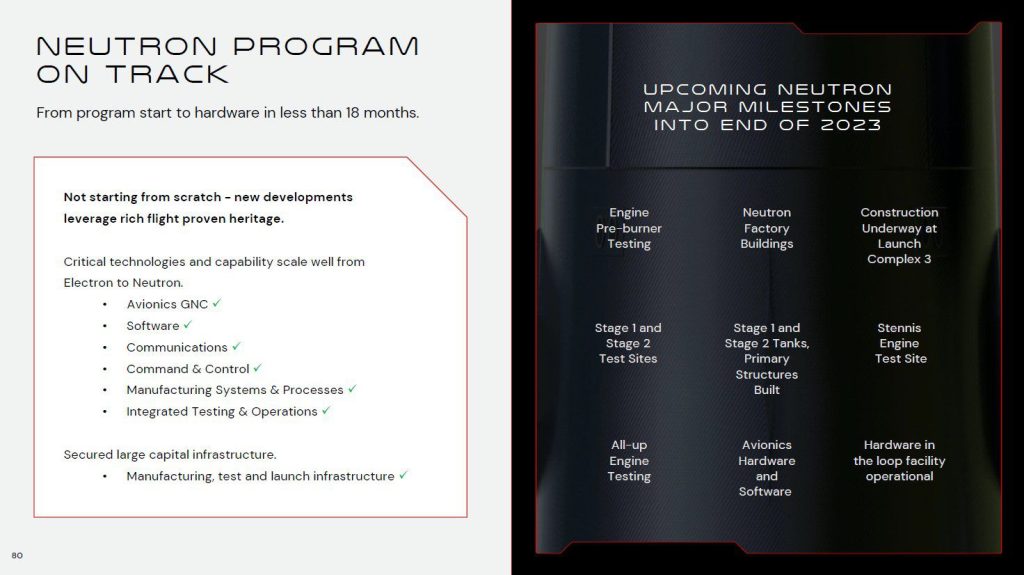
But again, SpaceX serves as a demonstration that what Rocket Lab hopes to achieve is not impossible. SpaceX went directly from Falcon 1 (about twice as large as Electron) to Falcon 9 V1.0 (about 30% smaller than Neutron) after just two successful launches of the smaller rocket. Electron has successfully launched 29 times since May 2017 and Rocket Lab is already learning about reusability through the smaller rocket. The challenges facing Rocket Lab are huge, but Neutron still remains the most promising SpaceX competitor currently in development. Kicking off full-scale Neutron tank testing just 2-3 years after the rocket was revealed would only reiterate its strengths. Stay tuned to see how much Neutron progress Rocket Lab can make in 2023.

News
Tesla FSD’s newest model is coming, and it sounds like ‘the last big piece of the puzzle’
“There’s a model that’s an order of magnitude larger that will be deployed in January or February 2026.”

Tesla Full Self-Driving’s newest model is coming very soon, and from what it sounds like, it could be “the last big piece of the puzzle,” as CEO Elon Musk said in late November.
During the xAI Hackathon on Tuesday, Musk was available for a Q&A session, where he revealed some details about Robotaxi and Tesla’s plans for removing Robotaxi Safety Monitors, and some information on a future FSD model.
While he said Full Self-Driving’s unsupervised capability is “pretty much solved,” and confirmed it will remove Safety Monitors in the next three weeks, questions about the company’s ability to give this FSD version to current owners came to mind.
Musk said a new FSD model is coming in about a month or two that will be an order-of-magnitude larger and will include more reasoning and reinforcement learning.
He said:
“There’s a model that’s an order of magnitude larger that will be deployed in January or February 2026. We’re gonna add a lot of reasoning and RL (reinforcement learning). To get to serious scale, Tesla will probably need to build a giant chip fab. To have a few hundred gigawatts of AI chips per year, I don’t see that capability coming online fast enough, so we will probably have to build a fab.”
NEWS: Elon Musk says FSD Unsupervised is “pretty much solved at this point” and that @Tesla will be launching Robotaxis with no safety monitors in about 3 weeks in Austin, Texas. He also teased a new FSD model is coming in about 1-2 months.
“We’re just going through validation… https://t.co/Msne72cgMB pic.twitter.com/i3wfKX3Z0r
— Sawyer Merritt (@SawyerMerritt) December 10, 2025
It rings back to late November when Musk said that v14.3 “is where the last big piece of the puzzle finally lands.”
With the advancements made through Full Self-Driving v14 and v14.2, there seems to be a greater confidence in solving self-driving completely. Musk has also personally said that driver monitoring has been more relaxed, and looking at your phone won’t prompt as many alerts in the latest v14.2.1.
This is another indication that Tesla is getting closer to allowing people to take their eyes off the road completely.
Along with the Robotaxi program’s success, there is evidence that Tesla could be close to solving FSD. However, it is not perfect. We’ve had our own complaints with FSD, and although we feel it is the best ADAS on the market, it is not, in its current form, able to perform everything needed on roads.
But it is close.
That’s why there is some legitimate belief that Tesla could be releasing a version capable of no supervision in the coming months.
All we can say is, we’ll see.
Investor's Corner
SpaceX IPO is coming, CEO Elon Musk confirms
However, it appears Musk is ready for SpaceX to go public, as Ars Technica Senior Space Editor Eric Berger wrote an op-ed that indicated he thought SpaceX would go public soon. Musk replied, basically confirming it.
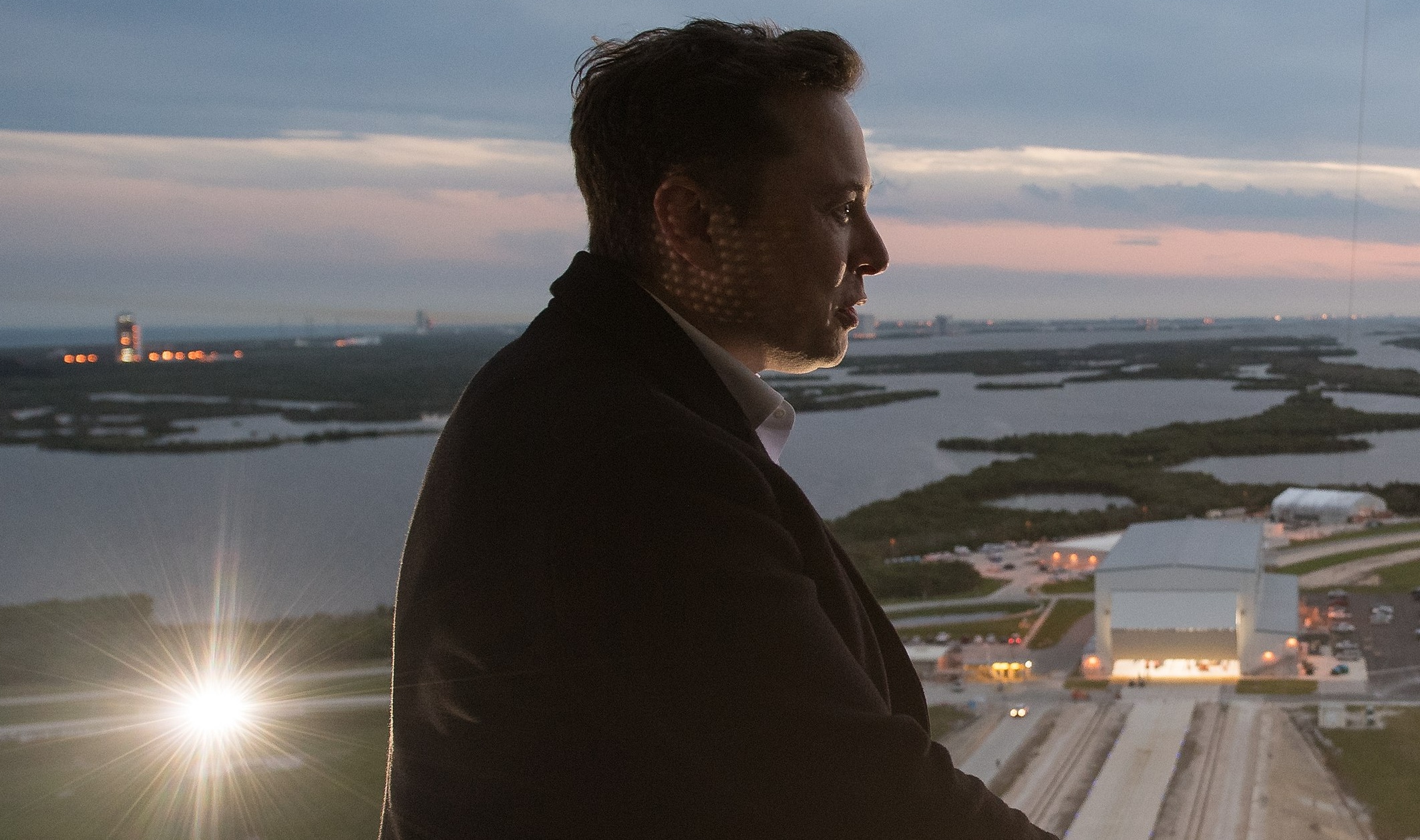
Elon Musk confirmed through a post on X that a SpaceX initial public offering (IPO) is on the way after hinting at it several times earlier this year.
It also comes one day after Bloomberg reported that SpaceX was aiming for a valuation of $1.5 trillion, adding that it wanted to raise $30 billion.
Musk has been transparent for most of the year that he wanted to try to figure out a way to get Tesla shareholders to invest in SpaceX, giving them access to the stock.
He has also recognized the issues of having a public stock, like litigation exposure, quarterly reporting pressures, and other inconveniences.
However, it appears Musk is ready for SpaceX to go public, as Ars Technica Senior Space Editor Eric Berger wrote an op-ed that indicated he thought SpaceX would go public soon.
Musk replied, basically confirming it:
As usual, Eric is accurate
— Elon Musk (@elonmusk) December 10, 2025
Berger believes the IPO would help support the need for $30 billion or more in capital needed to fund AI integration projects, such as space-based data centers and lunar satellite factories. Musk confirmed recently that SpaceX “will be doing” data centers in orbit.
AI appears to be a “key part” of SpaceX getting to Musk, Berger also wrote. When writing about whether or not Optimus is a viable project and product for the company, he says that none of that matters. Musk thinks it is, and that’s all that matters.
It seems like Musk has certainly mulled something this big for a very long time, and the idea of taking SpaceX public is not just likely; it is necessary for the company to get to Mars.
The details of when SpaceX will finally hit that public status are not known. Many of the reports that came out over the past few days indicate it would happen in 2026, so sooner rather than later.
But there are a lot of things on Musk’s plate early next year, especially with Cybercab production, the potential launch of Unsupervised Full Self-Driving, and the Roadster unveiling, all planned for Q1.
News
Tesla adds 15th automaker to Supercharger access in 2025

Tesla has added the 15th automaker to the growing list of companies whose EVs can utilize the Supercharger Network this year, as BMW is the latest company to gain access to the largest charging infrastructure in the world.
BMW became the 15th company in 2025 to gain Tesla Supercharger access, after the company confirmed to its EV owners that they could use any of the more than 25,000 Supercharging stalls in North America.
Welcome @BMW owners.
Download the Tesla app to charge → https://t.co/vnu0NHA7Ab
— Tesla Charging (@TeslaCharging) December 10, 2025
Newer BMW all-electric cars, like the i4, i5, i7, and iX, are able to utilize Tesla’s V3 and V4 Superchargers. These are the exact model years, via the BMW Blog:
- i4: 2022-2026 model years
- i5: 2024-2025 model years
- 2026 i5 (eDrive40 and xDrive40) after software update in Spring 2026
- i7: 2023-2026 model years
- iX: 2022-2025 model years
- 2026 iX (all versions) after software update in Spring 2026
With the expansion of the companies that gained access in 2025 to the Tesla Supercharger Network, a vast majority of non-Tesla EVs are able to use the charging stalls to gain range in their cars.
So far in 2025, Tesla has enabled Supercharger access to:
- Audi
- BMW
- Genesis
- Honda
- Hyundai
- Jaguar Land Rover
- Kia
- Lucid
- Mercedes-Benz
- Nissan
- Polestar
- Subaru
- Toyota
- Volkswagen
- Volvo
Drivers with BMW EVs who wish to charge at Tesla Superchargers must use an NACS-to-CCS1 adapter. In Q2 2026, BMW plans to release its official adapter, but there are third-party options available in the meantime.
They will also have to use the Tesla App to enable Supercharging access to determine rates and availability. It is a relatively seamless process.








